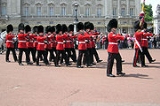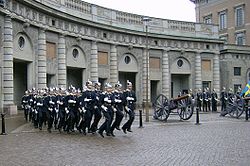
Military step
Encyclopedia

Walking
Walking is one of the main gaits of locomotion among legged animals, and is typically slower than running and other gaits. Walking is defined by an 'inverted pendulum' gait in which the body vaults over the stiff limb or limbs with each step...
of military formations.
History
The steady, regular marchingMarching
See also: Loaded marchMarching refers to the organized, uniformed, steady and rhythmic walking forward, usually associated with military troops.Marching is often performed to march music, and often associated with military parades....
step was a marked feature of Roman legion
Roman legion
A Roman legion normally indicates the basic ancient Roman army unit recruited specifically from Roman citizens. The organization of legions varied greatly over time but they were typically composed of perhaps 5,000 soldiers, divided into maniples and later into "cohorts"...
s. Vegetius
Vegetius
Publius Flavius Vegetius Renatus, commonly referred to simply as Vegetius, was a writer of the Later Roman Empire. Nothing is known of his life or station beyond what he tells us in his two surviving works: Epitoma rei militaris , and the lesser-known Digesta Artis Mulomedicinae, a guide to...
, the author of the only surviving treatise on the Roman Empire's military, De Re Militari
De Re Militari
De Re Militari , also Epitoma Rei Militaris, is a treatise by the late Latin writer Vegetius about Roman warfare and military principles as a presentation of methods and practices in use during the height of Rome's power, and responsible for that power...
, recognized the importance of "constant practice of marching quick and together. Nor is anything of more consequence either on the march or in the line than that they should keep their ranks with the greatest exactness. For troops who march in an irregular and disorderly manner are always in great danger of being defeated. They should march with the common military step twenty miles in five summer-hours, and with the full step, which is quicker, twenty-four miles in the same number of hours. If they exceed this pace, they no longer march but run, and no certain rate can be assigned."
Military marching of foot formations into a battle was a common practice in most European countries for centuries, and was even carried over into the new world as recently as the American War of Independence
American Revolutionary War
The American Revolutionary War , the American War of Independence, or simply the Revolutionary War, began as a war between the Kingdom of Great Britain and thirteen British colonies in North America, and ended in a global war between several European great powers.The war was the result of the...
. Since then, it has been phased out by advances in military equipment and tactics
Military tactics
Military tactics, the science and art of organizing an army or an air force, are the techniques for using weapons or military units in combination for engaging and defeating an enemy in battle. Changes in philosophy and technology over time have been reflected in changes to military tactics. In...
; however, Foot drill
Foot Drill
A Foot drill is an essential part of the training regimen of organized military and paramilitary elements worldwide. "Foot drill" or "Drill" stems from time since antiquity when soldiers would march into battle, be expected to gather in a formation, and react to words of command from their...
remains an important part of military education and training
Military education and training
Military education and training is a process which intends to establish and improve the capabilities of military personnel in their respective roles....
.
Marching types
The following commands specify different types of marching- Quick March: This is an instruction to begin marching at the Quick March speed with the left foot. The standard pace is 120 beats per minute with a 30in. step, although there are variances to this, based on the individual regiments, the pace given by the commander, and the speed of the band's rhythm: British light infantryLight infantryTraditionally light infantry were soldiers whose job was to provide a skirmishing screen ahead of the main body of infantry, harassing and delaying the enemy advance. Light infantry was distinct from medium, heavy or line infantry. Heavy infantry were dedicated primarily to fighting in tight...
and rifle regiments, for example, Quick March at 140 beats per minute, a legacy of their original role as highly mobile skirmishers. Highland Regiments, which march to bagpipe music, march at 112 paces per minute. The way the march is performed is based on the regiment's nationality. Western BlocWestern BlocThe Western Bloc or Capitalist Bloc during the Cold War refers to the powers allied with the United States and NATO against the Soviet Union and the Warsaw Pact...
nations typically lift their opposite arm up to the breast pocket, kept straight and used similar to a guided pendulum. Eastern BlocEastern blocThe term Eastern Bloc or Communist Bloc refers to the former communist states of Eastern and Central Europe, generally the Soviet Union and the countries of the Warsaw Pact...
nations and several Latin American, Asian and African nations frequently used the Goose Step, or keep their legs straight during the entirety of the step. Both of these are actually functional, as they maintain individual pace, unit pace uniformity, and actually help the soldiers march in their relatively elevated pace. The United StatesUnited StatesThe United States of America is a federal constitutional republic comprising fifty states and a federal district...
command is "For-ward, MARCH." Arm movement is kept to 9 inches to the front and 6 inches to the rear (6 inches and 3 inches, respectively, in the U.S. Navy, Marine Corps, and Air Force) while marching, while the interval between ranks and files is both 40 inches. The light infantry version of the march is also used by the Spanish LegionSpanish LegionThe Spanish Legion , formerly Spanish Foreign Legion, is an elite unit of the Spanish Army and Spain's Rapid Reaction Force. Founded as the Tercio de Extranjeros , it was originally intended as a Spanish equivalent of the French Foreign Legion, but in practice it recruited almost exclusively...
during parades. - Slow March: This is a ceremonial pace, used for funeral marches and when a unit's colours are marched out in front of the troops. The feet are kept parallel to the ground and the arms are never used. In the United States forces, usually only the band executes a slow march. In Spain, Latin America and the Philippines this is done during religious processions whenever a military band joins it. This march style is the official parade march in the armed forces of BoliviaBoliviaBolivia officially known as Plurinational State of Bolivia , is a landlocked country in central South America. It is the poorest country in South America...
and EcuadorEcuadorEcuador , officially the Republic of Ecuador is a representative democratic republic in South America, bordered by Colombia on the north, Peru on the east and south, and by the Pacific Ocean to the west. It is one of only two countries in South America, along with Chile, that do not have a border...
and the military academies and schools of VenezuelaVenezuelaVenezuela , officially called the Bolivarian Republic of Venezuela , is a tropical country on the northern coast of South America. It borders Colombia to the west, Guyana to the east, and Brazil to the south...
, done with the goosestep during parades and ceremonies. The standard pace is 60 paces per minute. - Half Step March or Cut the pace: This is a U.S. march pace. It is at the same tempo as Quick Time, but instead of 30 inches, the step is 15 inches.
- Double March: This is essentially a moderate jog at approximately 180 paces per minute. It creates a travel speed of approximately double that of Quick Time, designed to be used even when carrying heavy burdens. This is often erroneously used to describe a sprint or an ordinary run. The U.S. command is "Double Time, MARCH." This is also used by the elite airborne units and special forces of the National Armed Forces of Venezuela on parades and ceremonies.
- Easy March: This is an unrestricted march at approximately Quick Time. This is designed for field marches and other rough conditions, though is not used in combat areas. The U.S. command is "Route-step, MARCH."
- Mark Time: This is essentially a stationary march with the knees coming up parallel to the ground or the foot dangling six inches off of the ground. The time of what they were previously marching is kept or Quick March is used if no time is supplied. This is designed to maintain the time of large parades when portions need no forward speed, but is also used as a common punishment for physical training because of its tiring nature. United States service members move the knees upward approximately 6 inches.
- Step For -Ward or Forward or Forward, March: This causes troops marking time to resume a normal march. If it is implicitly used (as when the marking time is used to align formations or to wait for the former rank to pass when entering "Column of Route" from a depth-style formation) the (typically) Right Marker stomps his foot to signal it to the rest of the troops.

